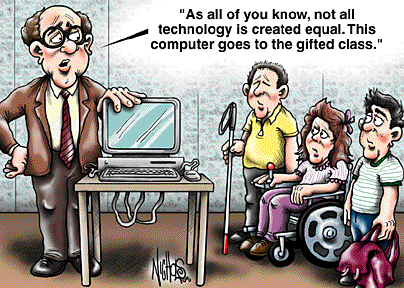In
my philosophy of education, I state that it is my belief that students learn best through active participation and
interaction with their peers and the instructor through the use of different
teaching and learning strategies. This should not only be my creed because it is
something all educators must take into consideration. Every student who walks
into the classroom has a preferred style of learning or some sort of need on
the teacher’s part to assist them daily in the way they learn. Sometimes,
certain students require more assistance than others due to disabilities. This
is where the accommodations of Assistive Technology, commonly known as AT,
plays a vital role. Getting access to such devices, however, is probably the
biggest challenge for students with disabilities and those working with them.
In the video, Assistive Technology: Enabling Dreams, Dr. Sheryl
Burgstahler of the University of Washington Disabilities Opportunities
Internet-working and Technology Program says, “Even though there is a lot of
technology available for people with disabilities, it isn’t implemented that
much in our school systems today and there are a lot of reasons for that. One
is that people who work with students with disabilities, this could be
teachers, lab managers, parents, often aren’t aware of the technology that is
available for them, and then technology is not always included in the planning
process.” Assistive technology has been progressing at the same rate as other
types of technology. The problem is that people who need them have no idea that
such devices exist or where to even look for it. When this happens, students
with disabilities are educated at a slower-rate and the contents of what they
are learning are watered down to basics to accommodate them. It is my belief
that the fault, in these situations, lie with the school system and its
educators. Educators should be able to assess a student’s needs within the
first few days to first few weeks of class and find appropriate accommodations.
 |
| Technology has different purposes, but its users are all equal. |
In another sense, I believe that educators are sometimes
not informed of the various AT devices available for their students. This is
why I believe that a course that provides instruction
on assistive
technologies and methodology for all teachers should be required. According to
Terence Cavanaugh of the University of Florida, “To provide more extensive
experience and education to instructional and educational technology
specialists concerning assistive technology, a course should be devoted to the presentation
of the basic concepts and applications of assistive technology.” When educators
are familiar with AT devices and how to apply them in their classroom, students
who are in need of them will be able to benefit from them. According to Special
Education teacher Ann Marie Pulcini in the Assistive Technology: Powerful Solutionsfor Success preview video, AT devices empower students with disabilities because
it accommodates them and makes things easier or more at their level.
Once teachers become familiar with AT devices and how to
incorporate them in their instruction, the earlier students can learn how to
use them. In the video Assistive Technology: Enabling Dreams, Redwood Heights Elementary
School teacher, George Rehmet, asserts, “By introducing ids to technology early,
it gets them better prepared and makes it easier down the road and then they
can spend the later years of their school years focusing on content material and
the curriculum.” This goes back to my belief that some teachers water down
content material for students with disabilities because they have no AT devices
to help their students grasp everything as efficiently and effectively as other
students do. There is a need in our education system to detect early students
with disabilities and get them the appropriate AT devices needed to help them
learn so that they can begin learning how to use these devices at an early age.
When this is achieved, the content material for students with disabilities would
be at a higher level and students will be able to get more out of their
education than just watered-down basics. Students with disabilities should not
be treated any different than students without disabilities. If they need
assistance, we should help them. However, they should never be made to feel
like they have fewer opportunities than others do.
I believe that teachers should be able to adjust their
teaching strategies to accommodate the variety of learning needs their students
have. Instead of just special education teachers, all teachers should be
required to take some course that provides information and instruction on the
use of AT devices in their classrooms. Teachers, together with parents, should
work together in detecting each student’s needs, if any, at an early age to get
them the necessary help for them to move forward in their education. Technology
is moving the world forward, and we must not be held back to all traditional
aspects of education. Students are more diverse than they were back then, so we
must use technology to accommodate diversity, especially for special needs
students. In the words of Dr. Sheryl Burgstahler, “Technology has changed all
of our lives but for these students, technology truly changes their life and
the opportunities that they’ll have in the future.”
References
Cavanaugh, T. (n.d.).
The Need for Assistive Technology in Educational
Technology. Jacksonville, FL: University of North Florida. Retrieved
from file:///C:/Users/User/Downloads/article_17778.pdf
Technology. Jacksonville, FL: University of North Florida. Retrieved
from file:///C:/Users/User/Downloads/article_17778.pdf
Edutopia. (2010, July
28). Assitive Technology: Enabling Dreams [Video file].
Retrieved from http://www.youtube.com/watch?v=rXxdxck8Gic
Retrieved from http://www.youtube.com/watch?v=rXxdxck8Gic
Natprofes. (n.d.). Assistive
Technology: Powerful Solutions for Success preview
[Video file] Retrieved from http://www.youtube.com/watch?v=faepVmPsRvQ
[Video file] Retrieved from http://www.youtube.com/watch?v=faepVmPsRvQ